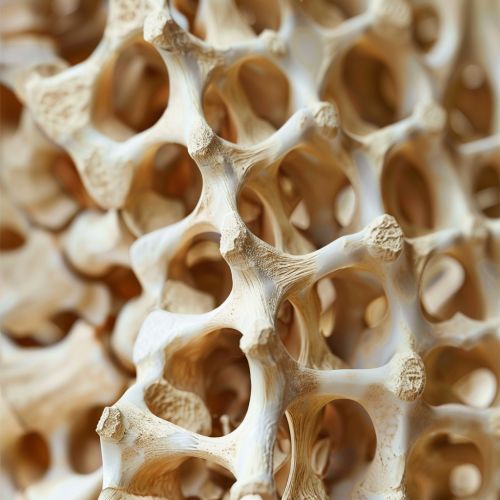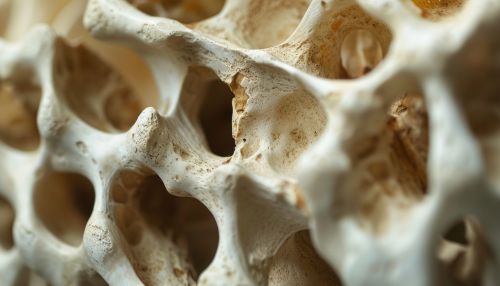Bone
Anatomy and Function
Bones are rigid organs that constitute part of the endoskeleton of vertebrates. They support and protect the various organs of the body, produce red and white blood cells, store minerals, provide structure and support for the body, and enable mobility. Bones come in a variety of shapes and sizes and have a complex internal and external structure. They are lightweight yet strong and hard, and serve multiple functions.


Composition
Bones, like much of the rest of the body, are made up of water and organic and inorganic materials. The organic part of bone consists of collagen, a protein that provides a soft framework, and proteoglycans, which are compounds that provide resistance to compression. The inorganic part of bone is made up of mineral, mostly hydroxyapatite and other salts of calcium and phosphate.
Collagen
Collagen is the main component of the organic part of bone. It forms a mesh-like framework that gives the bone its tensile strength, flexibility, and its resistance to stretching and bending. The collagen fibers in bone are arranged in a specific pattern that allows them to withstand the various forces that the body encounters during movement.
Minerals
The inorganic part of bone is made up of hydroxyapatite and other salts of calcium and phosphate. These minerals give the bone its hardness and rigidity. They are arranged in a specific pattern that allows the bone to withstand the various forces that the body encounters during movement.
Development
Bone development, or osteogenesis, begins in the embryo with the formation of a cartilage model that gradually becomes replaced by bone. This process, known as endochondral ossification, continues into adolescence and early adulthood. In adults, bone continues to remodel itself, responding to changes in mechanical stress and repairing damaged bone.
Endochondral Ossification
Endochondral ossification is the process by which the embryonic cartilaginous model of most bones contributes to longitudinal growth and is gradually replaced by bone. During this process, chondrocytes in the cartilage model proliferate and hypertrophy, and the extracellular matrix becomes calcified. This calcified matrix is then resorbed and replaced by bone.
Bone Remodeling
Bone remodeling is a lifelong process where mature bone tissue is removed from the skeleton (a process called bone resorption) and new bone tissue is formed (a process called ossification or new bone formation). These processes also control the reshaping or replacement of bone following injuries like fractures but also micro-damage, which occurs during normal activity.
Classification
Bones can be classified in various ways: by their shape, by their location, and by their structure. The classification by shape includes long bones, short bones, flat bones, and irregular bones. The classification by location includes axial bones and appendicular bones. The classification by structure includes compact bone and spongy bone.
By Shape
Long bones are characterized by a shaft, the diaphysis, that is much greater in length than width. They are primarily composed of compact bone. The epiphyses are at the ends of the bone and are mostly spongy bone. Examples of long bones include the femurs, tibias, and fibulas of the legs, the humeri, radii, and ulnas of the arms, and the phalanges of the fingers and toes.
Short bones are roughly cube-shaped, and have only a thin layer of compact bone surrounding a spongy interior. The bones of the wrist and ankle are short bones.
Flat bones are thin and generally curved, with two parallel layers of compact bones sandwiching a layer of spongy bone. Examples of flat bones include the sternum (breastbone), ribs, scapulae (shoulder blades), and the pelvis.
Irregular bones do not fit into the other categories and include bones such as the vertebrae and some skull bones.
By Location
The axial skeleton consists of the bones along the body's long axis, including the skull, vertebral column, and rib cage. The appendicular skeleton consists of the bones of the limbs, along with the pectoral and pelvic girdles.
By Structure
Compact bone, also known as cortical bone, is dense and forms the outer shell of all bones. Spongy bone, also known as cancellous or trabecular bone, is lighter and less dense than compact bone, and is found at the ends of long bones and in the interior of other bones.
Diseases and Disorders
There are many diseases and disorders that can affect the bones, including osteoporosis, osteogenesis imperfecta, Paget's disease, and bone cancer. These conditions can lead to a decrease in bone density, an increase in bone fragility, changes in bone shape, and can cause pain and disability.
